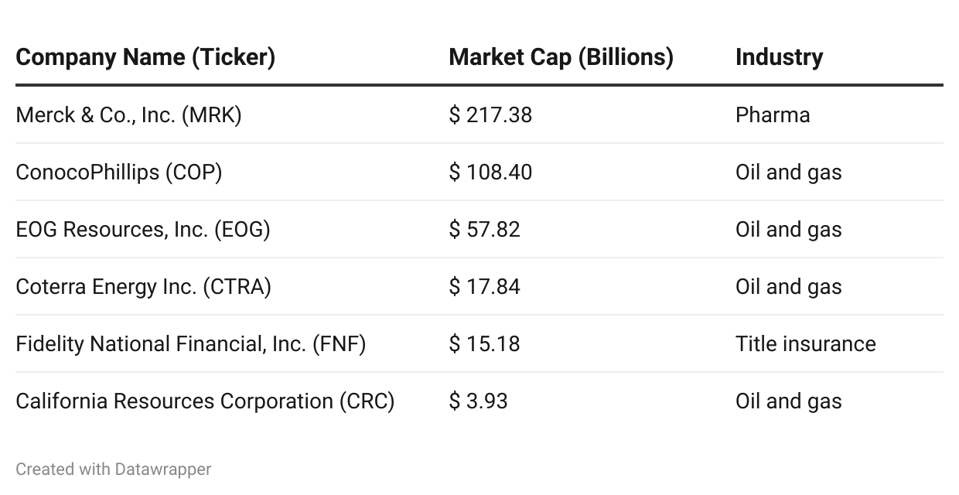With interest rates declining in the second half of 2025, dividend stocks are gaining renewed attention. A 3% or higher dividend yield now compares favorably with high-yield savings accounts — even before considering potential stock appreciation. For investors seeking income with growth potential, these six dividend-paying companies stand out this November.
How These Dividend Stocks Were Selected
These top six dividend stocks for November were screened for high-quality dividend payers using these criteria:
- Dividend yield of 3% or more
- Payout ratio below 60%
- Five-year free cash flow growth average of 10% or more
- Return on equity of 15% or more
- Positive analyst ratings
Energy stocks dominate this month due to strong cash flows and high yields, alongside one pharmaceutical and one real estate services company.
A review of each company follows. Metrics are sourced from company reports and stockanalysis.com. You can also find more investing ideas in: Best stocks for 2025.
Merck (MRK)
- Stock price: $87.24
- Dividend yield: 3.8%
- Payout ratio: 50.0%
- Five-year average free cash flow growth: 13.0%
- Debt/equity ratio: 0.7
- Five-year ROE average: 26.5%
Merck develops medicines, vaccines, and therapies for people and animals, with leading programs in oncology, vaccines, and infectious diseases.
Why MRK Is A Top Choice
Merck’s balance sheet, dividend yield, and research depth make it a standout in global pharma. Its blockbuster cancer drug Keytruda is the world’s best-seller, though softer Gardasil vaccine sales in China and a new $3 billion cost-cutting plan have weighed on shares. The pullback could create a buying opportunity as Merck expands through acquisitions like Verona Pharma and its COPD therapy Ohtuvayre.
Analysts expect Merck to increase EPS by 33.5% in 2025 and 7% in 202
ConocoPhillips (COP)
- Stock price: $86.79
- Dividend yield: 3.6%
- Payout ratio: 41.8%
- Five-year average free cash flow growth: 31.1%
- Debt/equity ratio: 0.4
- Five-year ROE average: 18.4%
ConocoPhillips is a leading independent oil and gas producer with operations spanning North America, Europe, Asia and the Middle East. The company focuses on exploration, production and liquefied natural gas (LNG) projects.
Why COP Is A Top Choice
COP’s scale, asset quality and cost efficiency protect against volatile energy prices. Investments in liquefied natural gas projects support growth, and the company is on track to distribute about 45% of cash flow from operations to shareholders. Analysts expect EPS to decline 17.2% in 2025, then rise 2.4% in 2026 and 25.5% in 2027.
Analysts expect 2025 EPS for ConocoPhillips to decline by 17.2% before it increases by 2.4% and 25.5% in 2026 and 2027.
EOG Resources
- Stock price: $105.90
- Dividend yield: 3.9%
- Payout ratio: 38.3%
- Five-year average free cash flow growth: 24.0%
- Debt/equity ratio: 0.2
- Five-year ROE average: 20.6%
EOG Resources is a U.S. exploration and production company with major assets in oil, natural gas and natural gas liquids. The company operates in the Permian, Eagle Ford and other key basins.
Why EOG Is A Top Choice
EOG generates more than $4.5 billion in free cash flow annually, which it deploys conservatively into capital programs and shareholder returns, supporting a 19% compound annual growth rate for the EOG dividend over the past year. The stock price is currently down 20% from a May 2022 high above $133, offering a buying opportunity for dividend investors who can handle volatility.
Analysts expect 2025 EPS for EOG Resources to decline by 10.8% before it increases by 8% and 17.7% in 2026 and 2027.
Coterra Energy (CTRA)
- Stock price: $23.38
- Dividend yield: 3.8%
- Payout ratio: 41.4%
- Five-year average free cash flow growth: 52.9%
- Debt/equity ratio: 0.3
- Five-year ROE average: 16.0%
Coterra Energy is an oil and natural gas producer formed by the 2021 merger of Cabot Oil & Gas and Cimarex Energy. It operates across diverse U.S. regions, including the Permian Basin and Marcellus Shale.
Why CTRA Is A Top Choice
Coterra combines operational efficiency with shareholder-focused capital returns. Free cash flow supports dividends and buybacks, while debt reduction and production discipline position it for steady performance. Analysts forecast EPS growth of 61.7% in 2025 and 34.4% in 2026, offering strong upside potential.
Analysts project Coterra Energy’s 2025 and 2026 EPS to increase 61.7% and 34.4%, respectively.
Fidelity National Financial, Inc. (FNF)
- Stock price: $55.86
- Dividend yield: 3.7%
- Payout ratio: 50.9%
- Five-year average free cash flow growth: 41.1%
- Debt/equity ratio: 0.5
- Five-year ROE average: 18.7%
Fidelity National Financial is the largest title insurance provider in the U.S. It also offers real estate transaction services and annuity products through subsidiary operations.
Why FNF Is A Top Choice
Fidelity National stands out among the strong cash flow generators on this list. While the other companies generate FCF per share between $1.94 and $8.29, Fidelity National produces $24.76. The company uses the funds to maintain strong liquidity while paying dividends and strategically investing to protect future margins.
Analysts expect Fidelity National Financial to increase its EPS by 5% in 2025 and 32.5% in 2026.
California Resources Corporation (CRC)
- Stock price: $46.92
- Dividend yield: 3.3%
- Payout ratio: 21.5%
- Five-year average free cash flow growth: 12.3%
- Debt/equity ratio: 0.3
- Five-year ROE average: 67.1%
CRC produces oil and natural gas while advancing carbon capture and emissions-reduction projects in California.
Why CRC Is A Top Choice
CRC’s low leverage, operational efficiency, and shareholder returns support a 3.3% dividend. Strategic acquisitions and CCS initiatives create long-term growth opportunities, with EPS projected to rebound after 2025–2026 declines.
Analysts expect CRC’s EPS to decline by 12.2% in 2025 and 27.7% in 2026. A rebound to 36 no.7% EPS growth is expected in 2027.
Bottom Line
These six dividend stocks offer yield stability, free cash flow, and shareholder-friendly strategies. They are well-suited for income-focused investors as interest rates fall and markets adjust to slower growth.

